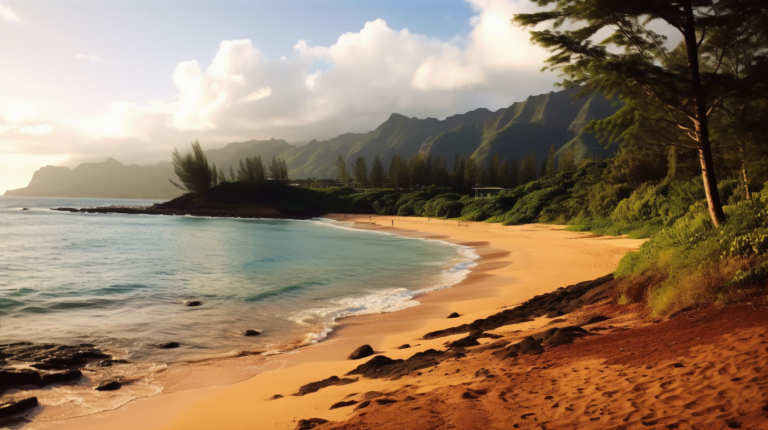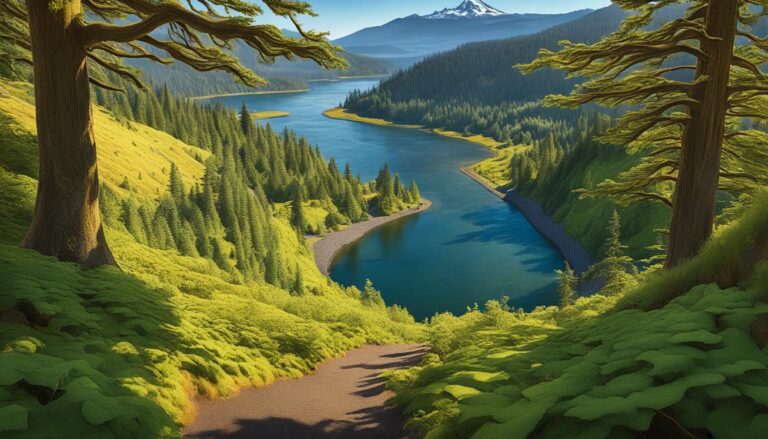Exploring National Parks in North America Guide
Are you ready to embark on an extraordinary journey through the breathtaking landscapes and natural wonders of North America’s national parks? From iconic favorites to scenic marvels and wilderness treasures, these parks offer a gateway to awe-inspiring beauty and unforgettable adventures. Discover the best national parks across the continent that will leave you in awe and inspire a deeper connection with the great outdoors.
Key Takeaways:
- Experience the natural wonders and scenic beauty of North America’s national parks.
- Explore a diverse range of parks, each with its own unique features and attractions.
- Plan your trip and research destinations, packing essentials, and seasonal considerations.
- Maximize your experiences by participating in outdoor activities and guided tours.
- Respect and protect the parks’ natural beauty through responsible travel and conservation practices.
Why Visit National Parks in North America
National parks in North America offer a unique opportunity to immerse yourself in the beauty of the natural world. These protected areas not only preserve and conserve diverse ecosystems and wildlife habitats but also provide a wide range of recreational activities for visitors.
From hiking and camping to wildlife watching and photography, national parks offer endless opportunities for outdoor adventure and discovery. You can witness stunning landscapes, roam through ancient forests, marvel at majestic waterfalls, and encounter a plethora of wildlife in their natural habitats.
Not only do national parks offer outdoor recreation, but they also provide a sanctuary to appreciate the awe-inspiring natural beauty that is often unseen in our daily lives. The serene tranquility, the vast wilderness, and the striking vistas found within these parks can be a powerful antidote to the hustle and bustle of urban life.
In addition to their natural beauty, national parks play a crucial role in promoting nature conservation and environmental stewardship. By visiting these parks, you can support conservation efforts and contribute to the sustainable management of these precious natural resources.
Eco-tourism is a rapidly growing trend, encouraging travelers to explore and appreciate the environment while making positive contributions to local communities and conservation organizations. By engaging in eco-friendly practices and supporting local economies, visitors can help ensure the long-term preservation of these incredible natural wonders.
Immerse yourself in the wonders of nature, experience outdoor adventures, and contribute to the conservation of our planet by embarking on a journey to the national parks in North America. Discover the magic of these pristine destinations and create memories that will last a lifetime.
Preparing for Your National Parks Adventure

Before embarking on an unforgettable journey through the breathtaking national parks in North America, it’s essential to make the necessary preparations to ensure a smooth and enjoyable trip. Here are some key considerations to keep in mind:
Researching Your Destinations
To make the most of your national parks adventure, it’s important to conduct thorough research about the parks you plan to visit. By familiarizing yourself with the attractions, activities, and regulations of each park, you’ll be well-prepared to make the most of your experience. Utilize online resources, such as park websites and official guides, to gather information about park hours, entrance fees, hiking trails, camping facilities, and wildlife sightings. This research will help you create a detailed itinerary and ensure you don’t miss out on any must-see sights.
Packing Essentials for Park Exploration
Proper packing is key to a successful national parks adventure. Be sure to pack the essential items to enhance your park exploration. Here’s a list of items to consider:
- Comfortable clothing and appropriate footwear for hiking and outdoor activities
- Sunscreen, insect repellent, and a hat to protect you from the elements
- A sturdy backpack to carry your essentials during hikes
- A reusable water bottle to stay hydrated
- Camping gear if planning to camp, including a tent, sleeping bag, and cooking supplies
- Food supplies and snacks for longer trips
- Binoculars and a camera to capture the incredible sights and wildlife
Understanding Seasonal Timing
The seasons play a significant role in determining the best time to visit national parks. Understanding the seasonal timing will help you plan your trip around optimal weather conditions, wildlife sightings, and crowd levels. Consider the following:
- Spring and fall: These seasons often offer mild weather, vibrant landscapes, and fewer crowds.
- Summer: The peak tourist season with longer days and warmer temperatures, but also larger crowds.
- Winter: Certain parks offer unique winter experiences, such as snowshoeing, cross-country skiing, and wildlife viewing.
By considering the seasonal aspects of your visit, you can maximize your enjoyment and make the most of your national parks adventure.
Navigating the Wide Array of National Parks

With 63 diverse national parks in North America, each offering its own unique features and attractions, navigating the wide array of options can be overwhelming. It helps to understand the different categories of national parks to identify the ones that align with your interests and preferences. Here are some of the park categories you can explore:
- Historical Parks: These parks preserve and celebrate important historical sites and landmarks. You can explore ancient ruins, learn about significant events, and gain insights into the nation’s history.
- Marine Parks: If you enjoy water-based activities, marine parks offer opportunities to dive into crystal-clear waters, snorkel around stunning coral reefs, and witness marine life in their natural habitats.
- Wilderness Parks: For those seeking rugged adventure and solitude, wilderness parks provide vast expanses of untouched wilderness, allowing you to hike through remote and challenging terrains.
- Geological Parks: These parks showcase unique geological wonders such as impressive rock formations, canyons, and arches. You can marvel at the forces of nature that shaped the landscapes over millions of years.
Whatever your interests, there is a national park that caters to them. Whether you’re looking to explore ancient ruins, dive into crystal-clear waters, hike through rugged wilderness, or marvel at geological wonders, the diverse national parks in North America have something for everyone.
Exploring these diverse park categories will allow you to immerse yourself in the natural beauty and unique features of each park. Whether you’re captivated by historical sites, fascinated by marine life, or inspired by wild landscapes, the national parks in North America offer endless opportunities for discovery and adventure.
Top National Parks to Include in Your Itinerary

When planning your national parks itinerary, it’s essential to include some of the top must-visit parks in North America. These iconic national parks offer breathtaking landscapes, unique features, and incredible opportunities for exploration and adventure. Let’s take a closer look at three categories:
Iconic Favorites: Yellowstone and Yosemite
Yellowstone and Yosemite National Parks are renowned for their awe-inspiring beauty and iconic landmarks. Yellowstone, the first national park in the world, is home to geothermal wonders like the famous Old Faithful geyser and the mesmerizing Grand Prismatic Spring. Yosemite, with its iconic Half Dome and breathtaking waterfalls like Yosemite Falls, captivates visitors with its majestic granite cliffs and serene meadows.
Scenic Marvels: Glacier and Zion
Glacier and Zion National Parks offer breathtaking landscapes and stunning scenery. Glacier National Park in Montana boasts snow-capped mountains, crystal clear lakes, and magnificent glaciers that have shaped the rugged terrain. Zion National Park in Utah showcases striking red cliffs, deep canyons, and verdant forests, with iconic hikes like Angels Landing and The Narrows.
Wilderness Wonders: Denali and the Everglades
Denali National Park in Alaska and Everglades National Park in Florida provide unique opportunities to explore untouched wilderness and encounter diverse wildlife. Denali is home to North America’s highest peak, Mount Denali, and offers vast expanses of untouched tundra, pristine rivers, and abundant wildlife, including grizzly bears and caribou. The Everglades, known as the “River of Grass,” is a unique subtropical wilderness, home to alligators, rare birds, and mangrove forests.
| Category | National Parks |
|---|---|
| Iconic Favorites | Yellowstone, Yosemite |
| Scenic Marvels | Glacier, Zion |
| Wilderness Wonders | Denali, Everglades |
The Optimal Seasons for National Park Visits

The optimal seasons for visiting national parks in North America depend on various factors, including weather conditions, wildlife sightings, and crowd levels. By planning your visit during the right season, you can enhance your park experience and make the most of your adventure.
Spring and fall are popular seasons for park visits, as the weather is mild, and the landscapes are often lush and vibrant. These seasons offer comfortable temperatures for outdoor activities like hiking and camping. Wildlife sightings are also common during these periods, as animals emerge from hibernation or migrate to their summer habitats.
Summer is the peak tourist season in national parks. During this time, the days are longer, allowing for more exploration and outdoor activities. However, be prepared for larger crowds, especially in popular parks. It’s advisable to book accommodations and make reservations well in advance to secure your spot.
Winter can be a unique time to visit certain parks, particularly those with snowy landscapes. If you enjoy winter activities like snowshoeing, cross-country skiing, or wildlife viewing in a winter wonderland, then visiting during this season might be ideal for you. However, keep in mind that winter weather conditions and park accessibility may vary, so check for any park closures or road restrictions before your trip.
Remember to consider your preferences and the specific features of each park when determining the best season for your visit. Whether you’re captivated by blooming wildflowers, autumn foliage, or snowy landscapes, national parks in North America offer something extraordinary in every season. Plan accordingly and get ready to embark on an unforgettable adventure!
National Parks in North America

With 63 national parks in North America, there are plenty of opportunities for park exploration and adventure. Navigating the diverse range of parks can be exciting, as you discover the unique landscapes, wildlife, and cultural heritage of each park. While the iconic parks like Yellowstone and Grand Canyon are must-visit destinations, don’t overlook the lesser-known gems that offer quieter surroundings and off-the-beaten-path experiences.
These hidden treasures provide a chance to escape the crowds and immerse yourself in the natural beauty and solitude of the parks.
Maximizing Your Experiences at Each Park

To make the most of your national park experiences, consider participating in a variety of outdoor activities and taking advantage of the resources and programs offered at each park. Engage in hiking, camping, wildlife watching, stargazing, and scenic drives to immerse yourself in the beauty and wonder of the parks. Join guided tours led by knowledgeable experts to gain deeper insights into the park’s history, geology, and ecology. Attend ranger programs and educational presentations to learn about the park’s natural and cultural heritage. By maximizing your experiences, you can create lasting memories and deepen your appreciation for these natural treasures.
When exploring national parks in North America, there are numerous outdoor activities that allow you to fully appreciate the stunning landscapes and diverse ecosystems. Hiking is a popular activity, offering the chance to explore scenic trails and discover hidden gems. Whether you prefer gentle strolls or challenging hikes, there are trails suitable for all skill levels. Camping is another fantastic way to immerse yourself in nature and enjoy a night under the stars. Many national parks offer designated campsites with basic amenities, allowing you to experience the tranquility of the great outdoors.
Wildlife watching is a favorite pastime in national parks, as these protected areas are home to a wide range of animal species. Keep your eyes peeled for bears, moose, elk, wolves, and various bird species. Remember to maintain a safe distance and never feed or approach wild animals. Stargazing is another incredible activity that can be enjoyed in national parks, away from light pollution. On clear nights, you can witness spectacular views of the night sky and marvel at the wonders of the universe.
Scenic drives are a fantastic way to explore the vast landscapes of national parks at your own pace. Many parks have designated scenic routes that showcase the most breathtaking vistas and natural wonders. Plan your route, take your time, and make frequent stops to soak in the beauty of the surrounding scenery. Don’t forget to bring your camera to capture those unforgettable moments.
In addition to self-guided exploration, national parks offer a variety of guided tours and ranger programs that provide valuable insights and enhance your understanding of the park’s significance. Join a guided tour led by park experts to learn about the geology, flora, fauna, and cultural history of the area. These knowledgeable guides can bring the park to life by sharing fascinating stories and highlighting points of interest along the way. Ranger programs and educational presentations offer unique opportunities to engage with park rangers and deepen your knowledge about the natural and cultural heritage of the park.
| Outdoor Activities | Guided Tours and Ranger Programs |
|---|---|
|
|
Respecting and Protecting Our Parks’ Natural Beauty

When visiting national parks in North America, it is crucial to respect and protect their natural beauty through responsible travel and environmentally friendly practices. By following the principles of Leave No Trace (LNT), you can minimize your environmental impact, preserve the integrity of the parks, and ensure future generations can continue to enjoy these pristine landscapes.
LNT Principles and Environmentally Friendly Practices
The principles of Leave No Trace provide a set of guidelines for responsible outdoor recreation. By adhering to these principles, you can help maintain the ecological balance and minimize human impact within national parks. Here are some LNT principles to keep in mind:
- Plan ahead and prepare: Research the park rules and regulations, pack appropriate gear, and plan your activities to minimize resource damage.
- Travel and camp responsibly: Stay on designated trails, camp in designated areas, and respect wildlife and vegetation.
- Dispose of waste properly: Pack out all trash, including food waste, and properly dispose of human waste following park guidelines.
- Leave what you find: Preserve the natural features, cultural artifacts, and historical structures within the parks.
- Minimize campfire impacts: Use existing fire rings, keep fires small, and follow park regulations and restrictions regarding campfires.
- Respect wildlife: Observe wildlife from a safe distance, do not feed or approach them, and store food securely to prevent conflicts.
- Be considerate of other visitors: Respect the peace and solitude of others, yield to hikers on trails, and avoid excessive noise.
By adopting these environmentally friendly practices, you can play a vital role in preserving the natural beauty and ecological balance of our national parks.
Engaging with Park Rangers for Insights and Safety
When exploring national parks, it is beneficial to engage with park rangers who serve as invaluable resources for insights, safety tips, and recommendations. Park rangers possess extensive knowledge about the parks, including the local flora and fauna, hiking trails, camping areas, and geological features.
Interacting with park rangers allows you to gain a deeper understanding and appreciation of the park’s natural and cultural heritage. They can provide valuable information about current park conditions, weather forecasts, wildlife sightings, and any safety concerns.
Furthermore, park rangers play a crucial role in maintaining visitor safety and ensuring the protection of park resources. They enforce park regulations, provide emergency assistance, and educate visitors about responsible travel practices.
By engaging with park rangers, you not only enhance your park experience but also contribute to the sustainable management and conservation of these precious natural resources.
Hiking and Camping Tips for National Park Explorers

Hiking and camping are popular activities in national parks, offering opportunities to immerse yourself in nature and explore the park’s hidden gems. Here are some essential tips to ensure a safe and enjoyable experience:
Hiking Tips:
- Wear sturdy and comfortable footwear to protect your feet and provide good traction.
- Dress in layers to accommodate changing weather conditions and always carry a waterproof jacket.
- Bring a backpack with essentials like water, snacks, a map, a compass, a first aid kit, a flashlight, and a multi-tool.
- Stay on marked trails to avoid getting lost and respect the park’s ecosystem.
- Observe wildlife from a safe distance and never feed or approach them.
- Leave no trace by packing out your trash and disposing of waste properly.
Camping Tips:
- Make reservations in advance to secure a campsite.
- Familiarize yourself with the park’s camping regulations, including quiet hours and fire restrictions.
- Set up your campsite in designated areas and follow campground etiquette.
- Pack appropriate camping gear, including a tent, sleeping bag, sleeping pad, cooking equipment, and food supplies.
- Practice Leave No Trace principles by minimizing your impact on the environment.
Backcountry Camping Tips:
- If you’re planning a backcountry camping trip, obtain the necessary permits and register your itinerary with park authorities.
- Research the park’s backcountry travel guidelines and familiarize yourself with the terrain and potential hazards.
- Carry a detailed map, a compass, and a GPS device to navigate remote areas.
- Prepare for self-sufficiency by packing lightweight and compact supplies.
- Ensure you have proper safety equipment, such as a bear-resistant food container and bear spray if necessary.
By following these hiking and camping tips, you can make the most of your national park adventure while ensuring your safety and preserving the natural beauty of these incredible wilderness areas.
Photographing the Majestic Landscapes of North America’s Parks

North America’s national parks offer endless opportunities for photographers to capture the majestic landscapes and captivating beauty of these natural wonders. Whether you are an experienced photographer or just starting out, these parks provide the perfect backdrop for stunning landscape photography.
Best Times of Day for Photography
When it comes to landscape photography, lighting is everything. The best times of day for capturing breathtaking images in national parks are usually during the early morning and golden hour in the evening. During these times, the light is softer, creates long shadows, and often has a warm, golden hue. This lighting enhances the natural beauty of the landscapes, making them appear more dramatic and ethereal.
Early morning photography allows you to capture the park in the soft light of dawn. The calm and quiet atmosphere during this time creates a sense of serenity and adds a magical touch to your images. Golden hour photography, on the other hand, takes place during the hour before sunset when the sky is filled with warm, golden tones. This creates a warm and inviting glow that adds depth and richness to your photos.
Of course, every park and location within the park will have its own unique lighting conditions and characteristics. Exploring different times of day and experimenting with lighting can lead to unique and captivating photographs.
Photography Gear: What to Bring with You
When heading out to photograph the landscapes of North America’s national parks, it’s essential to have the right photography gear with you. Here are some essential items to consider:
- A reliable camera: Invest in a high-quality camera that suits your needs and skill level. DSLR and mirrorless cameras are popular choices among landscape photographers for their versatility and image quality.
- Lenses: Wide-angle lenses are ideal for capturing vast landscapes, while telephoto lenses allow you to zoom in on distant subjects. Consider bringing a variety of lenses to cover different focal lengths.
- Tripod: A sturdy tripod is essential for capturing sharp and steady images, especially during low light conditions or long exposure shots.
- Filters: Neutral density (ND) filters can be used to control exposure and achieve long exposure effects, while polarizing filters help reduce glare and enhance colors.
- Versatile camera bag: Choose a camera bag that can comfortably carry all your gear and protect it from the elements. Look for a bag with adjustable compartments for easy organization.
Additionally, be prepared for changing lighting conditions, weather changes, and wildlife encounters by bringing extra batteries, memory cards, lens cleaning supplies, and protective gear for your camera and lenses.
To capture the true essence of North America’s national parks through photography, it requires patience, creativity, and a keen eye for detail. Embrace the beauty of the landscapes, explore different perspectives, and experiment with different techniques. By doing so, you can create breathtaking images that showcase the incredible natural wonders that these parks have to offer.
Creating a Memorable Road Trip Through National Parks

A road trip through national parks in North America can be an incredible adventure, allowing you to explore multiple parks and witness the diverse landscapes of the continent. When creating your road trip itinerary, consider mapping your route to include the parks that align with your interests and preferences. Research lodging options, including campgrounds, cabins, and lodges, and make reservations in advance. Plan your transportation, whether it’s by car, RV, or camper van, and ensure it’s suitable for the roads and terrains in the parks. Don’t forget to include pit stops along the way to rest, refuel, and explore nearby attractions. Create a memorable road trip that combines the excitement of the journey with the beauty of the national parks.
Mapping Your Route: Itinerary Suggestions
When mapping your road trip route through national parks, consider the following itinerary suggestions:
- Start your journey at iconic parks like Yellowstone and Yosemite, exploring their unique features and landmarks.
- Continue to scenic marvels like Glacier and Zion National Parks, where you can witness breathtaking mountain vistas and stunning natural wonders.
- Include wilderness wonders like Denali and the Everglades for a chance to experience untouched wilderness and encounter diverse wildlife.
By integrating these parks into your itinerary, you’ll create a diverse and unforgettable road trip experience.
Travel Tips: Lodging, Transport, and Pit Stops
Here are some travel tips to enhance your road trip through national parks:
- Lodging Options: Research different lodging options in and around the parks, such as campgrounds, cabins, and lodges. Make sure to book your accommodations in advance to secure your stay.
- Transportation: Choose a suitable mode of transportation for your road trip, whether it’s a car, RV, or camper van. Consider the roads and terrains within the parks when making your decision.
- Pit Stops: Plan for pit stops along your route to rest, refuel, and explore nearby attractions. This will break up the journey and allow you to experience the local culture and scenery.
By following these travel tips, you’ll ensure a comfortable and enjoyable road trip through the national parks in North America.
Conclusion
Embarking on a journey through the national parks in North America is an incredible opportunity to connect with nature, indulge in thrilling adventures, and gain a deep appreciation for environmental conservation. These parks offer a multitude of experiences that cater to every interest, from exploring iconic wonders to immersing oneself in scenic marvels and venturing into untamed wilderness. Each national park presents a unique and unforgettable adventure that will create cherished memories for a lifetime.
Whether you enjoy hiking through majestic landscapes, witnessing wildlife in its natural habitat, capturing breathtaking photos, or camping beneath the starry skies, these national parks provide countless opportunities to explore and be enchanted by the beauty of the natural world. With their awe-inspiring landscapes, diverse ecosystems, and rich biodiversity, these parks are a testament to the remarkable wonders North America has to offer.
As you plan your journey, remember the importance of environmental conservation. By treading lightly, practicing responsible travel, and adhering to the principles of Leave No Trace, you can help preserve and protect these precious natural resources for generations to come. National parks not only offer us a chance to create cherished memories but also serve as a reminder of the need to safeguard our planet’s natural beauty. So pack your bags, map your itinerary, and embark on an extraordinary adventure through North America’s national parks.







